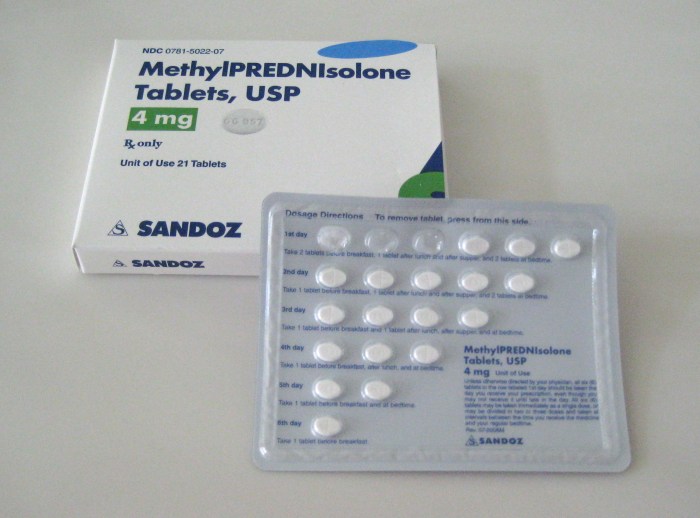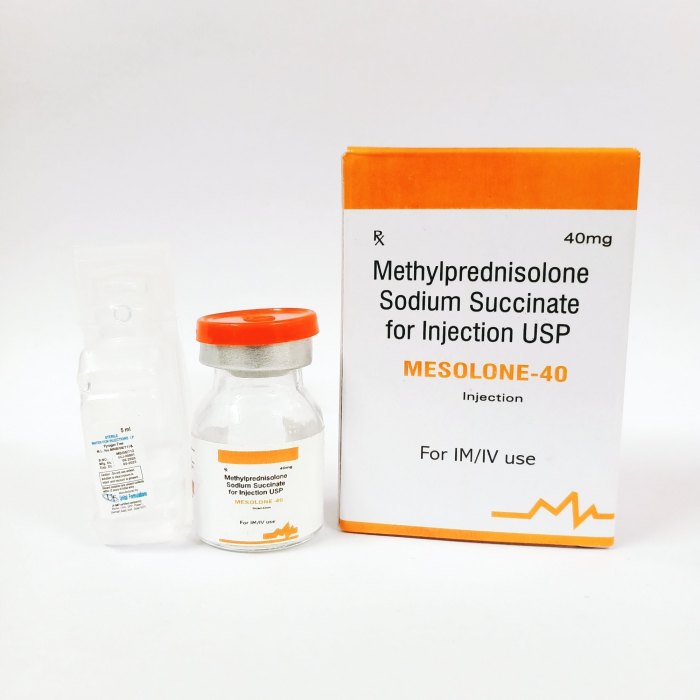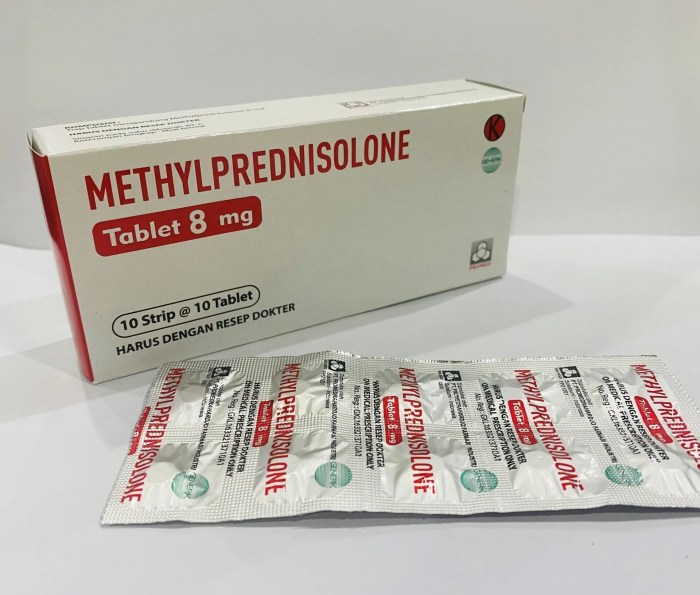Methylprednisolone, a potent synthetic corticosteroid, plays a pivotal role in managing a wide spectrum of inflammatory and autoimmune conditions. Its remarkable anti-inflammatory and immunosuppressive properties have made it a cornerstone of treatment for various medical specialties, including rheumatology, dermatology, and oncology.
This comprehensive guide delves into the intricacies of methylprednisolone, exploring its chemical structure, mechanism of action, pharmacokinetic properties, therapeutic indications, dosage and administration, adverse effects, drug interactions, contraindications and precautions, monitoring and management, clinical applications, and ongoing research and development.
Contraindications and Precautions

Methylprednisolone, a potent corticosteroid, is a valuable medication for various conditions, but it’s crucial to understand its potential risks and limitations. This section delves into contraindications, precautions, and the importance of patient education when using methylprednisolone.
Contraindications
Methylprednisolone is contraindicated in certain situations due to the potential for serious adverse effects. It’s crucial to carefully assess a patient’s medical history and current conditions before prescribing methylprednisolone.
- Systemic fungal infections: Methylprednisolone can worsen existing fungal infections and should not be used in patients with active systemic fungal infections.
- Active tuberculosis: Methylprednisolone can suppress the immune system, making patients more susceptible to tuberculosis. It should not be used in patients with active tuberculosis.
- Hypersensitivity to methylprednisolone or other corticosteroids: Individuals with known hypersensitivity to methylprednisolone or other corticosteroids should avoid using it.
Precautions
While not absolute contraindications, several precautions must be taken when administering methylprednisolone. These precautions aim to minimize the risks and optimize patient outcomes.
- Gastrointestinal issues: Methylprednisolone can increase the risk of gastrointestinal ulcers, bleeding, and perforation. Patients with a history of peptic ulcer disease or gastrointestinal bleeding should be carefully monitored.
- Diabetes mellitus: Methylprednisolone can elevate blood glucose levels, worsening diabetes control. Patients with diabetes mellitus should have their blood glucose levels closely monitored.
- Ocular complications: Long-term use of methylprednisolone can increase the risk of cataracts and glaucoma. Regular eye examinations are recommended for patients on long-term therapy.
- Immunosuppression: Methylprednisolone can suppress the immune system, making patients more susceptible to infections. Patients should be advised to avoid contact with individuals who are sick and to receive vaccinations as recommended.
- Mental health: Methylprednisolone can cause mood swings, anxiety, and psychosis, especially at high doses or with prolonged use. Patients should be monitored for mental health changes.
- Pregnancy and lactation: Methylprednisolone can cross the placenta and may be excreted in breast milk. Use during pregnancy and lactation should be carefully considered, weighing the potential benefits against the risks.
- Elderly patients: Elderly patients may be more susceptible to the adverse effects of methylprednisolone, such as bone loss, osteoporosis, and infections. Close monitoring is essential.
Patient Education and Counseling
Patient education is paramount to ensure safe and effective use of methylprednisolone. Patients should be informed about:
- The purpose of the medication: Explain the specific condition being treated and how methylprednisolone works.
- Potential side effects: Discuss common and serious side effects, emphasizing the importance of reporting any unusual symptoms to their healthcare provider.
- Proper dosage and administration: Instruct patients on the correct dosage, frequency, and route of administration. Emphasize the importance of following the prescribed regimen.
- Drug interactions: Advise patients about potential interactions with other medications they are taking. Encourage them to inform their healthcare provider about all medications, supplements, and herbal remedies they use.
- Long-term use risks: Discuss the potential risks associated with long-term use, such as bone loss, osteoporosis, and cataracts.
- Importance of follow-up: Emphasize the need for regular follow-up appointments to monitor their condition and adjust treatment as needed.
Monitoring and Management: Methylprednisolone

Methylprednisolone therapy requires careful monitoring and management to ensure optimal therapeutic effects while minimizing potential adverse effects. This involves regular assessments, appropriate adjustments to the dosage, and proactive strategies to manage complications.
Monitoring Parameters
Regular monitoring is crucial to assess the effectiveness of methylprednisolone therapy and to identify any potential complications. This involves:
- Clinical Assessment: Frequent monitoring of the patient’s clinical condition, including their symptoms, overall well-being, and response to treatment, is essential. This may involve assessing the severity of the underlying condition and observing for signs of improvement or worsening.
- Laboratory Tests: Routine laboratory tests are essential to monitor the patient’s response to methylprednisolone therapy and to detect any potential complications. These tests may include:
- Complete blood count (CBC) to assess for changes in white blood cell count, red blood cell count, and platelet count.
- Electrolyte levels (sodium, potassium, chloride, bicarbonate) to monitor for electrolyte imbalances.
- Liver function tests (LFTs) to monitor for liver toxicity.
- Kidney function tests (creatinine and blood urea nitrogen) to monitor for kidney damage.
- Blood sugar levels (glucose) to monitor for hyperglycemia.
- Thyroid function tests (TSH, T4) to monitor for thyroid dysfunction.
- Vital Signs: Regular monitoring of vital signs, including blood pressure, heart rate, respiratory rate, and temperature, is essential to detect any potential complications.
- Weight: Regular monitoring of weight is important to assess for fluid retention or weight loss, which may be associated with methylprednisolone therapy.
- Blood Pressure: Methylprednisolone can increase blood pressure. Regular monitoring of blood pressure is crucial to detect and manage hypertension.
- Blood Sugar: Methylprednisolone can increase blood sugar levels. Regular monitoring of blood sugar is crucial to detect and manage hyperglycemia, especially in patients with diabetes.
Managing Adverse Effects and Complications
Methylprednisolone therapy can cause a range of adverse effects and complications. Managing these potential issues requires a multi-faceted approach, including:
- Dosage Adjustment: The dosage of methylprednisolone may need to be adjusted based on the patient’s response to therapy and the development of any adverse effects. For example, if a patient experiences significant weight gain or hyperglycemia, the dosage may be reduced.
- Supportive Care: Providing supportive care to manage adverse effects can be crucial. This may involve:
- Fluid and Electrolyte Management: Monitoring and managing fluid and electrolyte imbalances, especially in patients with hypokalemia or hyponatremia.
- Gastrointestinal Protection: Using proton pump inhibitors or H2 receptor antagonists to prevent or manage gastrointestinal ulcers.
- Infection Prevention: Implementing infection prevention measures, such as hand hygiene and avoiding crowds, to minimize the risk of infections.
- Medications: Using medications to manage specific adverse effects, such as:
- Antihypertensives: To manage hypertension.
- Insulin or Oral Hypoglycemic Agents: To manage hyperglycemia.
- Antibiotics: To treat infections.
Patient Education and Follow-Up
Regular follow-up appointments are essential to monitor the patient’s progress, adjust the dosage as needed, and address any concerns. During these appointments, patients should be educated about:
- Importance of Adherence to Treatment: Emphasize the importance of taking methylprednisolone as prescribed, even if they feel better.
- Potential Adverse Effects: Discuss the potential adverse effects of methylprednisolone therapy, including the signs and symptoms to watch for.
- Importance of Monitoring: Explain the importance of regular monitoring, including laboratory tests, vital signs, and weight checks.
- Lifestyle Modifications: Provide guidance on lifestyle modifications, such as dietary changes and exercise, to help manage potential adverse effects.
- Importance of Reporting Side Effects: Encourage patients to report any side effects or concerns to their healthcare provider promptly.
Clinical Applications

Methylprednisolone, a potent corticosteroid, finds widespread use in various clinical settings due to its potent anti-inflammatory and immunosuppressive properties. It effectively manages a broad spectrum of conditions, ranging from acute inflammatory episodes to chronic autoimmune diseases.
Conditions Managed with Methylprednisolone
Methylprednisolone is commonly used to manage a wide range of conditions, including:
- Acute Inflammatory Conditions: Methylprednisolone is often used for conditions like acute exacerbations of asthma, allergic reactions, and inflammatory bowel disease. Its rapid anti-inflammatory effects help to reduce inflammation and improve symptoms.
- Autoimmune Diseases: Methylprednisolone plays a crucial role in managing autoimmune diseases like rheumatoid arthritis, systemic lupus erythematosus, and multiple sclerosis. It suppresses the immune system’s overactivity, reducing inflammation and tissue damage.
- Organ Transplantation: Methylprednisolone is a mainstay in preventing organ rejection after transplantation. It helps to suppress the immune system’s response to the foreign organ, improving graft survival.
- Cancer Treatment: Methylprednisolone can be used in conjunction with chemotherapy to manage side effects like nausea, vomiting, and inflammation associated with cancer treatment.
- Neurological Conditions: Methylprednisolone is used in the management of certain neurological conditions like Guillain-Barré syndrome, where it helps to reduce inflammation and improve nerve function.
Rationale for Use in Different Clinical Settings
The rationale for using methylprednisolone varies depending on the specific clinical scenario. Here are some key considerations:
- Rapid Symptom Relief: Methylprednisolone’s potent anti-inflammatory effects provide rapid symptom relief in conditions like acute exacerbations of asthma or allergic reactions. This quick action can be crucial in managing life-threatening situations.
- Suppression of Immune System: In autoimmune diseases, methylprednisolone helps to suppress the immune system’s overactivity, reducing inflammation and tissue damage. It can be used to control disease flares and improve long-term outcomes.
- Organ Rejection Prevention: After organ transplantation, methylprednisolone helps to prevent the body from rejecting the foreign organ. It suppresses the immune system’s response, allowing the transplanted organ to function properly.
- Management of Side Effects: Methylprednisolone can be used to manage side effects associated with cancer treatment, such as nausea, vomiting, and inflammation.
- Neurological Inflammation: In conditions like Guillain-Barré syndrome, methylprednisolone helps to reduce inflammation and improve nerve function.
Research and Development
Methylprednisolone, a potent corticosteroid, has been a mainstay in medicine for decades. Its efficacy in treating a wide range of inflammatory and autoimmune conditions has spurred ongoing research aimed at enhancing its therapeutic profile and exploring novel applications. This research focuses on developing new formulations, delivery methods, and therapeutic applications, while also investigating its use in specific diseases and populations.
New Formulations and Delivery Methods
Research into new formulations and delivery methods aims to improve the efficacy, safety, and convenience of methylprednisolone treatment. Current research efforts are exploring:
- Sustained-release formulations: These formulations are designed to release methylprednisolone over an extended period, potentially reducing the frequency of administration and improving patient compliance. Examples include methylprednisolone acetate suspension for intramuscular injection, which provides sustained release for up to 4 weeks, and methylprednisolone sodium succinate for intravenous infusion, which can provide sustained release for several hours.
- Targeted drug delivery: Researchers are investigating methods to deliver methylprednisolone directly to the target site, reducing systemic exposure and minimizing side effects. This approach utilizes carriers such as nanoparticles, liposomes, or antibodies to deliver the drug to specific tissues or organs. For example, researchers are exploring the use of nanoparticles loaded with methylprednisolone to target inflamed joints in rheumatoid arthritis.
- Novel routes of administration: Research is exploring alternative routes of administration, such as nasal, ocular, or topical delivery, to target specific areas of the body. For instance, nasal delivery of methylprednisolone is being investigated for the treatment of allergic rhinitis, while topical formulations are being explored for skin conditions like psoriasis.
Therapeutic Applications in Specific Diseases
Research is exploring the potential of methylprednisolone in treating specific diseases, including:
- Cancer: Methylprednisolone has shown promise in treating certain types of cancer, such as leukemia and lymphoma, often used in combination with chemotherapy. Researchers are investigating its role in enhancing the efficacy of cancer treatments and managing treatment-related side effects.
- Neurological disorders: Studies are investigating the use of methylprednisolone in treating neurological disorders like multiple sclerosis, spinal cord injury, and stroke. It is being explored for its potential to reduce inflammation and improve neurological function in these conditions.
- Infectious diseases: While primarily known for its anti-inflammatory properties, methylprednisolone may have a role in managing certain infectious diseases, such as sepsis, by modulating the immune response. Research is ongoing to understand its potential in these contexts.
Potential for Novel Therapeutic Approaches
Research is exploring the potential of methylprednisolone in novel therapeutic approaches, including:
- Gene therapy: Researchers are investigating the use of methylprednisolone in gene therapy to deliver therapeutic genes to target cells. This approach could potentially offer a more targeted and sustained treatment option for inflammatory and autoimmune conditions.
- Immunotherapy: Methylprednisolone is being explored as an adjunct to immunotherapy, a treatment approach that aims to stimulate the immune system to fight disease. Its potential role in enhancing the efficacy of immunotherapy is being investigated in various conditions.
- Combination therapy: Research is investigating the use of methylprednisolone in combination with other medications, such as biologics, to achieve better therapeutic outcomes in various diseases. This approach aims to synergize the effects of different drugs and enhance their efficacy.
Future Research Directions, Methylprednisolone
Future research related to methylprednisolone will likely focus on:
- Optimizing existing formulations: Continued research will aim to improve the pharmacokinetic properties of existing formulations, such as enhancing bioavailability, extending duration of action, and minimizing side effects.
- Developing personalized treatment strategies: Research will explore the use of pharmacogenomics to tailor methylprednisolone dosage and treatment regimens based on individual patient characteristics, potentially leading to more effective and safer treatment.
- Investigating long-term effects: Further research is needed to understand the long-term effects of methylprednisolone treatment, particularly in vulnerable populations, such as children and older adults.
Understanding methylprednisolone’s multifaceted nature is crucial for healthcare professionals and patients alike. This guide provides a comprehensive overview of this important medication, encompassing its pharmacological properties, clinical applications, and potential risks and benefits. By carefully considering the information presented, individuals can make informed decisions regarding the use of methylprednisolone in managing various medical conditions.
Methylprednisolone, a corticosteroid, is often prescribed for a range of inflammatory conditions. While it’s crucial to follow your doctor’s instructions for medication, it’s also important to understand the potential interactions with other drugs. For instance, if you’re taking a stimulant like vyvanse generic , it’s vital to discuss this with your physician to ensure safe and effective treatment.
Understanding the potential interactions between medications like methylprednisolone and other drugs is key to maintaining your health and well-being.